SPORT IN CHINA
 Sport arguably has not been as important in Chinese society as it has been in the West. But that doesn't mean sports weren't played. In ancient times Chinese nobility played “cuju”, a game somewhat similar to soccer, and “chuiwan”, which resembles golf. A Tang-era painting shows an emperor playing a polo-like game with ladies of his court.
Sport arguably has not been as important in Chinese society as it has been in the West. But that doesn't mean sports weren't played. In ancient times Chinese nobility played “cuju”, a game somewhat similar to soccer, and “chuiwan”, which resembles golf. A Tang-era painting shows an emperor playing a polo-like game with ladies of his court.
For decades the People’s Liberation Army teams have been the centerpiece of the Chinese sports system. Brook Larmer wrote in the Washington Post, "The PLA teams — called Bayi, or 8-1, for the date of the army’s founding — plucked the best young athletes from around the nation. Known for their brutal training regimens, PLA teams were so dominant in China from the 1950s through the 1980s that they were de facto national teams, and symbols of the country’s strength."
Many Western sports first came to China via missionaries. In the 19th and 20th century Protestant missionaries abroad emphasized the gospel of sport nearly as much as the Gospels themselves.
The Chinese didn't even have a word for "sport" or build stadiums until the 19th century when Europeans introduced their ideas of organized athletic activities. The closest homegrown activities to sports are “wushu”, a style of kung fu, and “tai chi”, a form of exercise which has more to do with self improvement and spiritual discipline than competition and entertainment. A mandarin taken to a tennis game in the 1940s told AP he couldn’t see the point: “It is much to much for me. I would hire coolies to do that kind of work.”
Organized, competitive sports in the Western sense began after the 1839-42 Opium Wars and was introduced mostly by missionaries and foreign traders and were played in the early years in the treaty ports, schools and other institutions set up by foreigners. Things like polo grounds, race tracks, tennis courts and swimming pools were set up for foreigners to amuse themselves not for Chinese. Some had signs that read “Chinese keep out.” A sign in front of Huangpu Park in the British quarter of Shanghai read "No admittance to Dogs and Chinese."
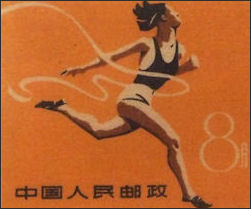
stamp from 1959
national sports event Only a small percentage of Chinese play organized sports and engage in Western-style sporting activities like jogging, swimming, golf and tennis. One Time reporter said that when she went jogging in Beijing people looked behind her to see who she was running from.
Even so a lot of Chinese engage in sports and physical activities for fun and exercise. People play ping pong and basketball to relax, kill time and spend time with friends. Parks are filled with men and women doing tai chi, line dances and other activities. A increasing number of Chinese are swimming and playing soccer. An effort is being to get kids involved in sport in school and athletics is becoming a bigger part of college life.
As a rule, even today, sports aren’t played as much iin Asia as they are outside Asia. Children are generally encouraged to spend their time studying not playing sports, with parents especially insisting that they study.
On of most common sports cheers in China is “jia you” (pronounced jah yoh), which is used like “come on, go, go, go!” but literally means “add oil!”
A Chinese rider, Li Fuyu, rode on Lance Armstrong’s Team Radioshack team. He was suspended from cycling in April 2010 after testing positive for steroids.
SPORTS IN CHINA factsanddetails.com
Seriousness about Sport in China
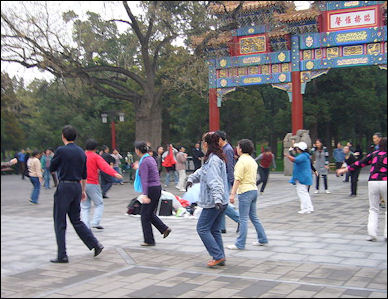
park exercise Brook Larmer wrote in the Washington Post: “For China, international sporting events are rarely just games; “face” is almost always at stake, even when the purpose is ostensibly diplomatic. The 2008 Beijing Olympics were portrayed not just as another Games, but as incontrovertible proof, for all to see, that China had arrived as a world power. [Source: Brook Larmer, Washington Post, August 19, 2011]
That impulse runs deep, back to the founding of the People’s Republic. In the 1950s, Mao created the country’s Soviet-style sports system with one purpose: to help China shake off its reputation — gained after a century of foreign domination — as the “weak man of Asia.”
When China earned its first world championship, in table tennis in 1959, ecstatic crowds flooded Tiananmen Square; Mao, exultant, compared the victory to a “nuclear bomb.” Years later, when China rejoined the Olympic movement, Deng Xiaoping’s “gold-medal strategy” — pouring resources into medal-rich sports — turned the quadrennial medal count into a barometer of national progress. Sure enough, China’s tally has leaped from five medals in 1988 to 51 in 2008, when it topped the United States for the first time.
Chinese, Westerners and Sport
Explaining why Western athletes often perform better than Chinese ones, many Chinese say it is because Westerners are bigger and stronger than Chinese and that Confucianism downplays the kind of individualism that produces good athletes. Some Chinese say that when their athletes do do better than Western athletes it is because Chinese food is more nutritious than Western-style fast food.
Many Chinese believe that Chinese excel in sports that emphasize coordination and flexibility, like gymnastics and diving, rather than strength and speed. Others are believers in the "net theory" — that Chinese do well in net sports like ping pong. volleyball and badminton because there is no direct contact between competitors.
One Chinese sports broadcaster told Sports Illustrated, "Ancient Chinese sports were always performances, always art. Sports were for health and exercise, not competition, So it's been a tradition for us to be better at performance sports, like diving and gymnastics and shooting, than competitive sports. Or, if the sport must be competitive, let it be table tennis or volleyball, where there's a net. Dividing the competitors is better, so there’s no body contact."
A number of Western sports including tennis, rugby, professional wrestling are all trying to generate interest in their sports in China. Even NASCAR is sending out feelers to China. See Baseball, Basketball, Team Sports
Communism and Sport in China
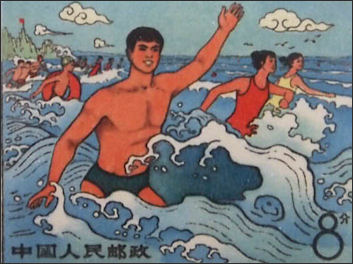
swimming stamp
The Communists have viewed sports as way for China to build a national psyche and overcome the humiliation suffered at the hands of foreigners. In 1917, in his first published article, Mao Zedong criticized the Chinese for not getting enough exercise and blamed their lack of physical fitness for China’s reputation as the “the sick man of Asia.” He wrote, “Our nation is wanting in strength. If our bodies are not strong, how can we attain our goals and make ourselves respected.”
There is a strong element of propaganda to Chinese sport. In its website the Beijing Olympic Committee said it was committed to “promoting mass sporting events on an extensive scale, improving the people’s physique, and spurring the socialist modernization of China.”
During the Cultural Revolution, competitive sports were effectively banned and the handful of elite athletes that existed at the time were charged with “jinbiao zhuyi” (“trophy mania”).
Sport in Communist China often has a scripted element to it. Maureen Fan wrote in the Washington Post: “China’s political culture places a unique emphasis on group performance. It’s an emphasis that starts as early as kindergarten, dominates the work lives of state employees and is used to demonstrate collective passion, where it might not otherwise exist. To...visitors the impulse to script and stage manage everything might seem odd. But China has long emphasized ceremony and propriety.”
David Barboza wrote in the New York Times, “Using state resources to achieve such lofty goals is part of the game. It is known, for instance, that in 2008 the Beijing Olympic torch relay was masterfully stage-managed for millions of viewers of state-run television here, with crowds bused in to line the relay route and cheer on the torch bearers. Soon after the torch runner passed by, the cheering crowds were ordered to get back onto their designated buses and head to the next location along the route, where they were expected to cheer for the cameras all over again. [Source: David Barboza, New York Times, November 2, 2010]
The state-funded, sports training programs in China are modeled after sports programs in the Soviet Union. See Olympics, See Ping Pong team
Sports, Communism and Athletes in China
Players are encouraged to be team players and play for the glory of China rather than themselves. If a player loses he has the burden of letting down the entire country not such himself or herself. Individuality is discouraged and regarded as a Western idea, expressed in Communist party propaganda terms as "the unhealthy American imperialist sport style of seeking headlines."
On her place on the team, one member of Chinese national women’s basketball team told the New Yorker, “To be honest, I don’t much like it. I wanted to be a dancer or an actress. I don’t think of it as something I did or didn’t want to do. I thought of it as a responsibility. It was a job.”
Star players are viewed as “intangible assets” of the state. If they become successful and make money they are expected to share that money with the government, coaches and their teams because they helped nurture and develop the star players.
On changes in attitudes among Chinese athletes one American Beijing resident told the Washington Post, “Here in China we care about the nation, In America you care about just the individual. This is changing, the young people here care about the individual now. They just want to play for themselves. For the older people they just want to play for the nation.”
It is common for athletes to fake their age with false identification cards so they can play in age-group competitions. There have been reports of players faking their ages by as much as four years. Based on X-ray bone analysis sports officials in Guangdong found that 20 percent of 15,000 young Chinese athletes they surveyed lied about their age.
Out of Shape China
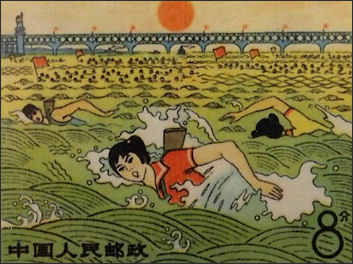
Swimming across the Yangtze River
stamp from 1976 “When it comes down to ordinary citizens rather than Olympic athletes, China is hardly the sports capital of the world,” Kent Ewing wrote in the Asia Times. “Indeed, it remains a backwater. China won a stunning 51 gold medals at Beijing in 2008 and built first-rate facilities to train athletes and paid coaches handsome salaries to manage that training, yet sports venues for ordinary Chinese remain few and far between in a nation that is woefully out of shape.[Source: Kent Ewing, Asia Times, September 5, 2008]
China seems to be getting fatter in the cities while remaining undernourished in the countryside. Most Chinese continue to live in rural areas, where poverty and malnourishment are commonplace. At the same time, in the burgeoning cities, American-style obesity has become a problem. According to the most recent data from the Ministry of Education, 8 percent of urban Chinese children between the ages of 10 and 12 are obese, while another 15 percent are overweight. Compare that to a 2006 report by the US Department of Health and Human Services, which did not identify a separate category for obesity but found that 18.8 percent of Americans aged 6 to 11 were overweight.
A national fitness program, introduced by the State Council, the cabinet, in 1995, has largely been deemed a failure. A new national fitness program, introduced after the 2008 Olympics which has set a goal of motivating 40 percent of the population to take up regular exercise by 2010, is supposed to improve matters. Part of this is requiring children to take one period of physical education every day in school.
“But the truth is that daily exercise in many schools amounts to little more than 10 minutes of stretching, and real exercise and participation in sports remain outside the experience of most Chinese.” Ewing wrote. “At the same time that the country has become an international sports superpower, it has not done much to encourage a sports culture at home.”
Lack of Sports Facilities in China
State media has reported that Beijing pumped 480 million yuan (US$70 million) into elite sports in 2005, while only 270 million yuan went toward public sports venues. A General Administration of Sport survey found there were 6.58 sports venues per 10,000 people in China, not even close to what can be found in most developed countries. For example, Japan has 200 sports venues per 10,000 people. Especially in rural areas, where only 8 percent of China's total sports facilities can be found, it's hard to find a place to play badminton, table tennis or any other sport. [Source: Kent Ewing, Asia Times, September 5, 2008]
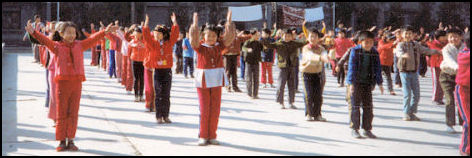
School exercise class
Typically, in China's many villages, the only public space for exercise is the playground of the local school. In Beijing and other big cities in the prosperous east, it is mostly the elderly one sees taking over public parks and even sidewalks for their daily dose of tai chi while the younger generation is too busy making money to take regular exercise. And, even in these cities, sports venues can be hard to find and expensive to use.
The technical operations manager of the Fengtai Olympic softball field, Sun Bojie, recently complained that there were only six softball fields in Beijing, a city of more than 17 million residents. No wonder, he said, the game had failed to capture the public imagination.
National Peasant Games in China
The National Peasant Games has been held in China since 1988. Events include the 60-meter rice transplanting race, pond fishing, the 100-meter tire pushing race and the “water-carrying contest to the seedlings amid drought” as well as conventional sports like tennis and basketball. In the “60-meter snatch the grain and get into storage” event contestants load a “harvest” of sandbags onto tricycles and sprint it the finish line. In the three-man, 100-meter dash three men have their legs tied together like contestants in a three-legged race.
The sixth National Peasant Games was staged in October 2008. According to Xinhua: “Unlike most sports which emphasize physical strength and competitiveness, the games for peasants place more emphasis on recreation and less on results.”
About 3,500 farm workers took part in the 2008 Games at the 32,000-seat Haixia stadium in a town outside Beijing. A contestant in the 60-meter rice-transplanting race told the Times of London, “Back home life is pretty hard, so this is our chance to show the country and the world what we do and our skills and abilities.” Another contestant said, “Although we were not able to attend the Beijing Olympics, this is our dream, our farmer’s Olympics. I do this back home. So it is closely matched to my daily life.”
Sports Business, Nike and Adidas in China
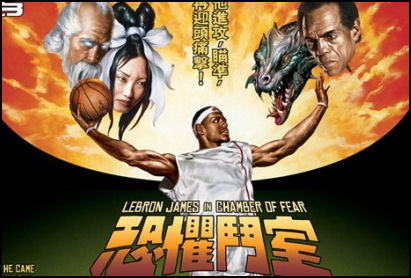
Nike ad The sports business in China has grown from about $1 billion a year in 1994 to $15 billion in 2008. Star athletes like basketball player Yao Ming and gold medal hurdler Liu Xiang have multimillion dollar endorsement deals, hawking everything from cell phones to cigarettes. Sports websites are among the most popular in China.
The NFL sent some star players and hot, busty cheerleaders to China in its bid to make inroads there. Even World Wrestling Entertainment is trying to establish itself in China.
The Chinese sports market is valued at around $10 billion a year, a fraction of the American $300 billion-a-year sports market.
Nike and Adidas are competing very hard in the Chinese market. Adidas reportedly spent $60 million for a high profile position in the Beijing Olympics in 2008. Nike puts most of its energy into supporting athletes. It sponsors 22 or the 28 competing Chinese sports federations and has contacts with top Chinese athletes such as basketball player Yao Ming and Olympic gold medal hurdler Liu Xiang. Both Nike and Adidas are experience soaring growth in China and expect top $1 billion sales in 2008.
One university students told U.S. News and World Report he was given $62 a month for expenses school and ate nothing but instant noodles all month and used the left money to buy Nike basketball shoes.
Both Adidas and Nike focus their marketing on brand stores rather than with Chinese retailers. Each has about 3,000 outlets in China (2007) and opens stores at a clip of about two a day.
Adidas's business doubled in 2004 and almost doubled again in 2005. It planned to increase outlets in China from 4,000 to 5,000 in 2008 and spend $200 million on marketing to take advantage if demand aroused by the 2008 Olympics.
China is Adidas’s second biggest market after the United States. Boosted by sales in the run-up to the Olympics, Adidas sales increased 60 percent in the first half of 2008. The company hopes to post $1.5 billion in sales in China in 2010.
See Golf
Performance-Enhancing Drug Makers in China
Many of the steroids, human growth hormones and other performance-enhancing drugs used by athletes around world are made in China or are made with ingredients made in China. In 2007, 124 people were arrested by U.S. officials in an investigation called “Operation Raw Deal” that uncovered a 27-state underground network that distributed steroids, human growth hormones and other performance-enhancing drugs. Almost all the drugs were made with ingredients that originated from 37 chemical companies in China.
Chinese companies began dominating the performance-enhancing drugs industry in 2005 when a U.S.-led crackdown all but shut down Mexico’s steroid industry. Some have accused the Chinese chemical companies of causing increased drug abuse by providing cheap ingredients and bringing down the prices of things like EPO — a drug used by endurance athletes that increases the oxygen levels in the blood — by making them affordable to athletes that could not afford them in the past.
Chinese-made performance-enhancing drugs have been tied to bodybuilders, Olympics competitors and big name professional athletes. One investigation found that Chinese ingredients were used to make designer steroids by BALCO, the Bay-area company accused of supplying performance-enhancing drugs to Barry Bonds and Marion Jones.
Among the Chinese chemical makers investigated by the New York Times that produced performance-enhancing drugs are GeneSciense Pharmaceutical, indicted on charges of smuggling and illegally selling human growth hormone; and Hunan Steroid, one of 37 companies named in Operation Raw Deal. Both of these companies were present at an exhibition for drug ingredient makers in Milan in 2007.
An investigation by the Washington Post found that four of the 37 companies were still selling steroids or ingredients to make steroid in late 2007. One company appeared to have closed down its operation in one province only to open up in another province. Another claimed it didn’t sell steroids but said it did sell stanozolol and anastrozole, both of which are kinds of steroids. Other companies claim they had no idea they were doing anything illegal. In many cases the laws are vague on the selling of these drugs, especially those involving steroids and human growth hormones, which have legitimate medical uses as well as illegal ones.
With the 2008 Olympics approaching there has been increased pressure on China to do something about the producers of performance-enhancing drugs as well as athletes that take them. Beijing authorities insist they are cracking down.
Athletes and Drugs, See Olympics and China
Motorsports
China’s top race driver Xu Lang was killed in June 2008 when a trailer tow hook struck him in the face during a rally in Russia. The accident occurred as Xu was helping pull another vehicle out of the mud. The towing cable broke and struck Xu hard in the face. Xu had competed in the Paris-Dakar race, where he drove for the Nissan Zhengzhou Corp team.
Shanghai also hosts a Moto GP motorcycle race.
Formula One in China
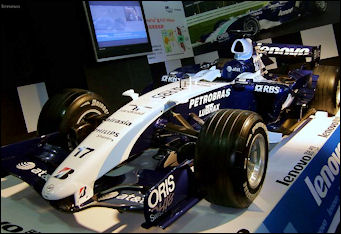
Lenovo Formula One car
China hosted its first Formula One race in 2004 and has a contact for seven years until 2010. The race was held in Shanghai on a 3.24 mile (5.4 kilometer), $244 million. track designed by renowned circuit designer Hermann Tilke to have curves like a Chinese dragon and accommodate 200,000 spectators, with a main grandstand for 50,000 people. Tickets for the event cost up to $500. To be able to attend is a sign of wealth and prestige.
Including associated costs, the Formula One track cost $350 million, making it the world’s most expensive Formula One raceway. Shanghai Formula One was part of massive corruption scandal involving the use of Shanghai’s multi-billion-dollar pension find. The head of Shanghai’s Formula One, Yu Zifei, was fired in 2007 for his connection with the misuse the pension funds. See Corruption
The China Grand Prix is held in September, late in the season when either the driver’s title is already decided or it is a neck and neck race. The race in 56 laps around the course. Ferrari’s Rubens Barrichello won the inaugural race in 2004 but some of the suspense was missing because Ferrari’s Michael Schumacher had already won the driver title. Alonso clinched the F-1 crown in 2005 with a victory in Shanghai.
About 40 million to 50 Chinese million watch Formula One races when they are broadcast on television. Schumacher and Ferrari are very popular in China. Schumacher had bad luck on the track at Shanghai. In 2004 he was 12th. In 2005 he was last when he endured a crash before the start of the race and was out of the race after a spin in the 22nd lap.
In 2006, the Shanghai Grand Prix was the third to last race and was the site of a pivotal showdown between Alonso with 108 points and Schumacher with 106 points.
The Chinese Grand Prix was moved to mid April in 2009 from October in 2008, making it the third race of 17 race season rather than one of the last as was the case before.
In November 2008, it was reported that Shanghai might drop its Formula One Grand Prix race after its 2010 contact runs out because the it loses so much money. The event has been plagued by poor ticket sales.
Formula One boss Bernie Ecclestone criticized promoters of the Chinese Grand Prix in 2010 for a lack of local publicity and declining crowds at the race and practice sessions leading up to it, but said the race will continue. “It’s a shame because the whole venue is super. They’ve not promoted it properly. It’s as simple as that. If you were in Shanghai you wouldn’t even know there was a race here.”
Formula One Results in China
In the 2007 race 22-year-old Lewis Hamilton had a chance to be the first rookie to clinch the driver’s championship but instead he slid into the gravel while entering the pit stop area on slick tires and was unable to extricate himself. The race was marred by rain. There were a number of crashes, spin outs and close calls. Having the right tires at the right time for the right weather conditions was the key to the race. Ferrari and Finland’s Kimi Raikkonen won.
Hamilton was the leader most the race. He made the mistake on lap 31 of the 56-lap race. It was the first time he was unable to finish a race the whole year. All he needed was second to clinch the driver’ title. Hamilton said after the race, “When I got out of the car I was just gutted because it was my first mistake all year and that I did it on the way to the pits was not something I usually do.”
Lewis Hamilton won the Chinese Grand Prix in Shanghai in October, 2008 with dominant pole to flag victory. Felipe Massa finished second, keeping the Formula One season title alive, after Ferrari team made Kimi Raikkoken let him pass.
The 2010 the Chinese Grand Prix was the forth race of the season and was held in April. Jenson Button and Lewis Hamilton placed first and second respectively for McLaren in a race that was marred by off and one rain and won by Button whose decision to stick with dry weather tires was the right one. Some drivers made five ro six pit stops to change tires to deal with the changing weather.
McLaren’s Lewis Hamilton won the 2011 Chinese Grand Prix in Shanghai in April, passing Formula One world champion Sebastian Vettel with just a few laps to go in the race. Hamilton almost didn’t make it to the starting line as his car had trouble starting. Vettel finished second. His Red Bull teammate Mark Webber finished third after starting 18th.
Indycar Racing in China
IndyCar will stage its first race in China on Aug. 19 2011 in the coastal city of Qingdao, located between Shanghai and Beijing. Qingdao staged the sailing portion of the 2008 Summer Olympics. This will serve as a replacement for Japan's Twin Ring Motegi race that has an expired contract. [Source: Lana Bandoim, Yahoo! News, November 12, 2011]
IndyCar has provided limited details for the 2012 race in China. Drivers will not be using an oval track. Instead, officials plan on a street course of 3.87 miles and possibly building a track in the future. The trip to Qingdao is the fourth official location confirmed by IndyCar for 2012. Previously, officials stated that drivers will race in Edmonton, Toronto and Sao Paulo. It seems that the IZOD IndyCar Series is attempting to expand to new markets and create fans overseas.
Japan's devastating earthquake in March 2011 damaged the Twin Ring Motegi. The oval track could not be used for the race this year, so it was moved to a street course. Although rumors circulated that the race in Japan would be completely cancelled, IndyCar officials refused to do this. The area suffered a 6.2 magnitude earthquake while drivers were in Japan in Sept. 2011, but no one was hurt.
Lana Bandoim of Yahoo! News wrote, “I do not believe that concern over future earthquakes or tsunamis is responsible for moving the race to China and abandoning Japan. Danica Patrick was one of the only drivers who repeatedly voiced her concerns about racing in Japan and was anxious about the impact of radiation on food. The large number of participants in the 2011 Twin Ring Motegi clearly indicates that there was an interest in the race.
It seems that the actual motivation for the change is sponsors. Randy Bernard, the CEO of IndyCar, has pointed out, "China was the No. 1 place our sponsors wanted to go outside of the United States." I think his statement clearly shows that the decision to move the race to China was not motivated by concern for drivers, radiation or earthquakes. Money was the only reason for the change.
Image Sources: 1) Nolls China website http://www.paulnoll.com/China/index.html ; 2) Landsberger Posters http://www.iisg.nl/~landsberger/; 3) Nike and UCLA Asia Institute; 4) Beijing 2008 Olympics website; Wiki Commons; Asia Obscura
Text Sources: New York Times, Washington Post, Los Angeles Times, Times of London, National Geographic, The New Yorker, Time, Newsweek, Reuters, AP, Lonely Planet Guides, Compton’s Encyclopedia and various books and other publications.
Last updated March 2012
